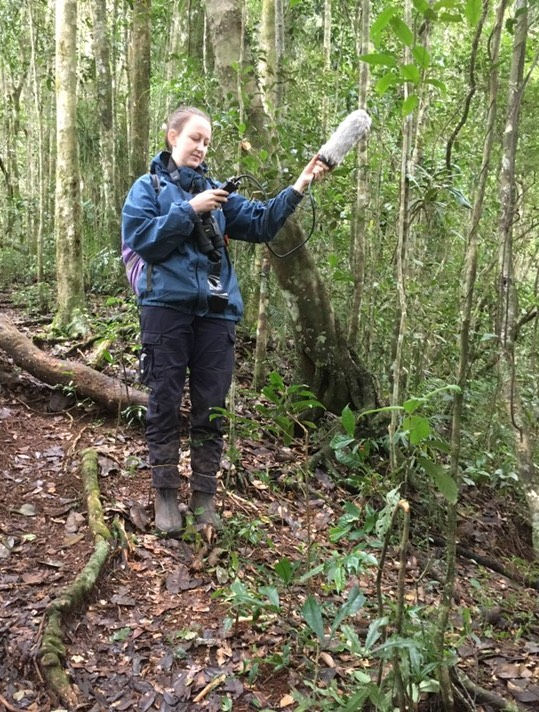Notes from the field: July 2019
- Carly Batist
- Jul 15, 2019
- 4 min read
The Highs & Lows of Fieldwork: Lack of Data to Lemur Love Triangles
Salama! I just got back to Centre ValBio (CVB) after my 3rd expedition into the forest at Mangevo and WOW has it been an exciting past few weeks (more on that later). However, during my 2nd expedition in late June, things did not go as planned, as is all too familiar to those who conduct field research. North America’s summer is the Malagasy “winter” which really means the dry season but temperatures can still get down into the low 50s at night. Being a born-and-bred New Yorker, calling this winter is comical considering the sub-zero temperatures and white-out blizzards that I grew up with…
But this June was anything but dry. It rained nearly non-stop for 10 days, something that was shocking to all the local guides as they had literally never experienced such a rainy June. And with rain, come leeches. So. Many. Leeches. On one day I picked off over 100 (and no that number is not a typo). But the worst thing about the cold rain is that the lemurs basically go into semi-conscious state and just sleep all day huddling to keep warm/somewhat dry. And they don’t vocalize, which presents a significant problem for me, as I am collecting-you guessed it-vocal data. But I’m now an expert at identifying what precise spot under which tree will shade you best from a downpour, so at least I can add that to my CV.

After a quick break at CVB for Malagasy Independence Day (the single most important week in the country--think Christmas, July 4th, New Year’s Eve, Halloween and Thanksgiving all in one), my team went back out for the 3rd expedition. I was so desperate for sunny days I started repeatedly singing a nursery rhyme called Mr. Sun that my mom sings to her preschool students. But my terribly off-pitch singing paid off because the first day of the 3rd expedition we saw the lemurs MATING!! I know what you’re thinking-ok cool yeah animals do that and why are you stalking these pairs who would probably like to be left alone by us hairless primates on the ground .
BUT ruffed lemurs have a boom/bust reproductive cycle so in a given year either all of the females in a group have babies or none of them do; they’re incredibly synchronized. If environmental conditions like climate or fruit availability aren’t just right, ruffed lemur groups can go up to 5 years without having babies. For a Critically Endangered species like this one, that’s pretty devastating. SO the fact that we had mating this year is HUGE and I was lucky enough to get a bunch of the ruffed lemur mating calls recorded! These calls are only used in the roughly 4 days of the year that females are receptive so I consider myself very lucky and was incredibly excited! So excited that while running after a lemur with my microphone and recorder, I entangled myself in a bamboo thicket that I then had to cut my way out of with a dull pocket knife. Another notable resume addition.
Now for the part I know you’re all waiting for-The Bachelorette: Varecia Edition. There was chasing. There was screaming. There was blood (literally-one of the males got too close to a female that wasn’t interested and she scratched a nice hole in his ear). Ruffed lemurs, like the majority of lemur species, are female-dominant (take note, Homo sapiens). So the males are stuck between fearing for their limbs when approaching females and their testosterone-fueled biological drive to reproduce. It paints quite the comical picture--think teenager who lost their phone but needs to tell mom and dad in order to get a new one. Obviously that is a completely hypothetical example and not at all based on my real life…

One subgroup has two adult females and one male, and this is where the love triangle comes in, because for a few days he mated with one and then switched to the other. Interestingly, one of the female’s older offspring didn’t seem to be keen on more siblings because she tried to break up the mating pair multiple times. Males would fight with each other for access to a female; one male was thrown off a branch and dropped a good 20 feet before catching himself right above the ground. It then took me a solid hour to regain a normal heartbeat.
So it’s been an eventful few weeks, from lows of no data for multiple days to highs of being one of a handful of people who have seen this species mate in the wild. That’s the nature of fieldwork, which requires adaptability and rewards a positive attitude, even when all of your rice (the base food in every Malagasy meal) molds overnight and you have to get an emergency delivery within hours. I’m looking forward to what fun (and not so fun) surprises my next and last expedition to Mangevo will bring!







































Comments